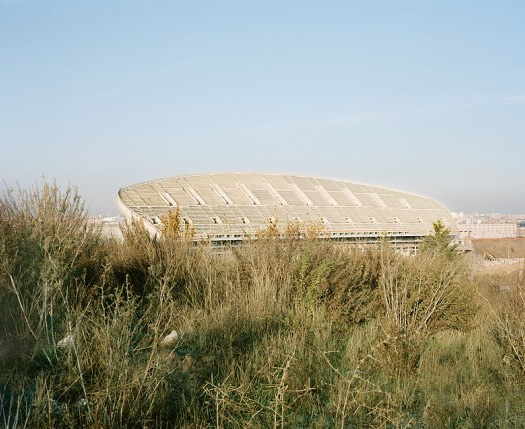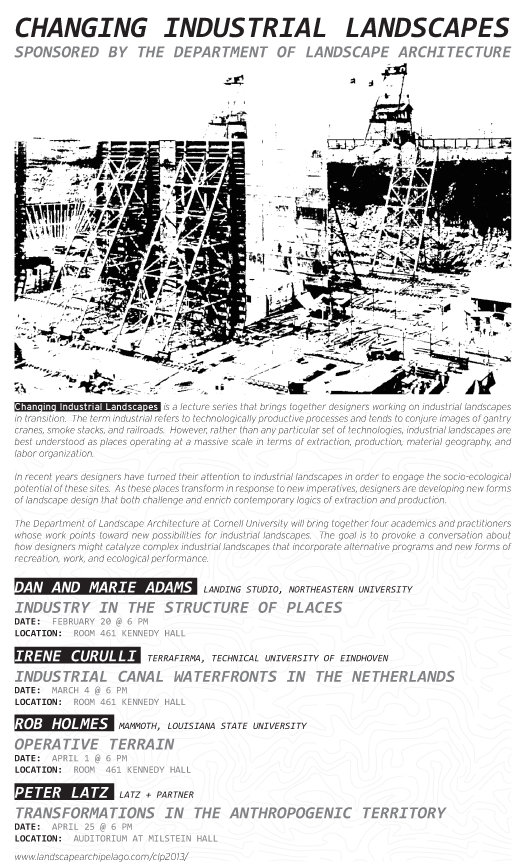Quickly, a pair of events (well, an event and an event series) that I am a bit late to mentioning.

[photograph by Ricardo Espinosa]
The first is “The City That Never Was”, a symposium “organized by Christopher Marcinkoski and Javier Arpa, in cooperation with the Architectural League of New York; speakers include Iñaki Abalos, Dominique Alba, Enric Batlle, William Braham, Rania Ghosn, Llàtzer Moix, Robin Nagle, Chris Reed, Willie van den Broek, James von Klemperer, Richard Weller and Daniel Zarza”, “us[ing] the current economic and urban crisis in Spain as a lens through which to consider future patterns of urbanization and settlement”:
“In the twenty years following its accession to the European Union in 1986, Spain underwent unprecedented physical development that radically reshaped its major cities and metropolitan areas. From new housing to commercial and cultural facilities to infrastructure, the country experienced a building boom of such remarkable proportions that by 2005, 20% of Spain’s GDP was attributable to construction-related activities. The equivalent figure for the United States at that time was less than 5%. A year later, The New York Times celebrated Spain as “one of the great architectural success stories in modern history” when reviewing the Museum of Modern Art’s 2006 exhibition On Site: New Architecture in Spain.
Yet today Spain copes with an unemployment rate in excess of 26% and a GDP — according to the latest IMF forecast — expected to shrink by 1.5% this year. The country is littered with unfinished, partially completed or abandoned developments including housing complexes left unenclosed; empty museum buildings with no collections; hundreds of miles of unused roads; and airports without a single arrival or departure. This condition is most severe in Madrid, where over 25% of the urbanized land in and around the city consists of partly vacant or incomplete projects.
However extreme its outcome, this overdevelopment is not unique to Spain. Rather, episodes of failed speculative urbanization are a recurrent circumstance throughout history, taking place at a range of scales with varying degrees of long-term effect. Recent examples of this phenomenon can be found in the Sunbelt region of the United States, as well as in Ireland, Iceland, Panama, Angola, Kenya, and the Persian Gulf. China in particular has been under increased scrutiny of late as a growing number of media reports and images emerge of massive, unoccupied new settlement being built in the country’s interior western and southern provinces. This proliferation globally of unoccupied and incomplete settlement over the past 20 years illustrates broader trends in the processes of urbanization, trends in which presumptions of — and desires for — continuous economic growth instigate intense financial investment and real estate speculation, seemingly indifferent to considerations of local and regional capacities, or changing market demands.
This one-day symposium will use the situation in Spain as a point of departure for challenging the increasingly generic strategies upon which contemporary urban planning and design rely in both established and emerging economies. The event will be organized through four primary themes related to the City That Never Was phenomenon— infrastructure, waste, landscape, and instant urbanism — in order to explore new possibilities for how future formats of urbanization can be conceived, financed, planned, deployed and inhabited.”
The symposium is tomorrow (I said I was a little bit late!), at the Scholastic Auditorium in New York. Tickets are available through the Architectural League’s website through 5 pm today, and then tomorrow at the door. The Architectural League has also produced a small set of features on the topic, including interviews and images, which can be found here.

The second — the event series — is “Changing Industrial Landscapes”, a subset of the “2013 Cornell Landscape Project” (within the landscape department at Cornell University, which is sponsoring the series). Thematically organized by the Student ASLA and instructors Thomas Oles and Brian Davis, “Changing Industrial Landscapes” focuses “on landscape projects working at the scale of past and future industrial practices”. Dan and Marie Adams of Landing Studio spoke first — last night — and Brian claims both that it was excellent and that he’ll have a summary up in the near future.
Irene Curulli follows on March 4, I speak on April 1, and Peter Latz on April 25.
I’ll be giving a version of a new talk I’ve been developing (debuted here at LSU this past Monday), on what I am dubbing “operative terrain”:
A Target, a Books-a-Million, a movie theater, a Starbucks, and a sea of parking; a switching yard filled with double-stacked railcars; a right-of-way, a shoulder, four lanes, a median, four lanes, a shoulder, and another right-of-way; a coal-fired power plant, ash ponds, dikes, sluices, diversion channels, and drying cells (fly ash slurry safely confined, it seems). Such landscapes constitute the bulk of contemporary urbanized territory and, given the regimes of resource extraction and flows of material and goods that mark even nominally rural landscapes, linking cities to distant hinterlands, it might be argued that most territory is urbanized. These landscapes are not so much designed as they are formatted by economic and logistical imperatives. Particularly notable among them are territories that are being actively formatted by industrial, infrastructural, and logistical operations: dredge containment facilities, waste reservoirs, exurban warehouse districts. This operative terrain is essential to the economies of urban systems, hosting and channelling the various material and energetic flows that enable urbanization, yet it also often generates a host of undesirable consequences, and may also–more optimistically–harbor unrealized potential. What is the role of landscape architecture within this terrain?
It’s an exciting talk for me, as it synthesizes many of mammoth‘s concerns from the past several years (including the unfortunately under-blogged 2012) and attempts to shovel them into a framework for one set of new directions for landscape architecture that I argue are critical to developing an effective disciplinary response to the scale of contemporary environmental challenges produced by anthropogenic activity. It’s probably even more exciting to see it situated within the context of a broader set of designers who are responding within this terrain (in much more effective ways than I am), so my only disappointment with the series is that I can’t be in Ithaca for the other three lectures. If you can, you should.

